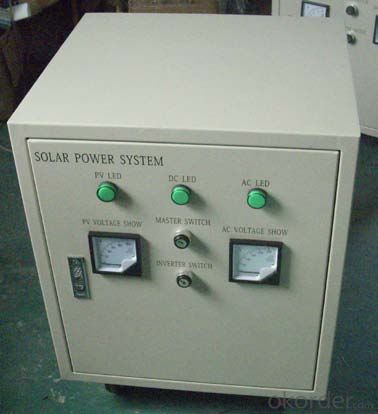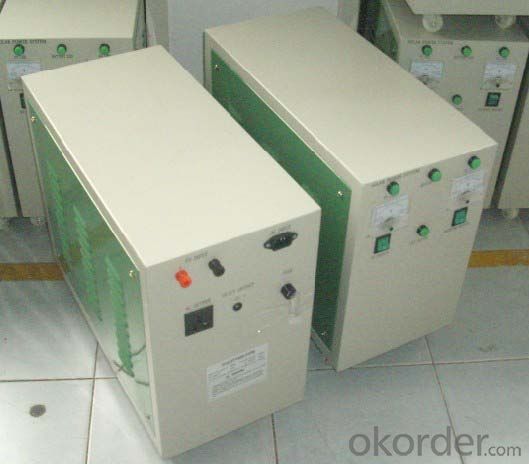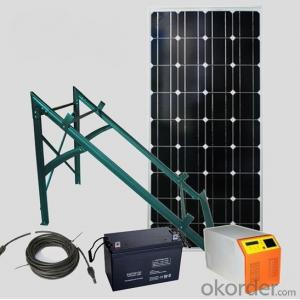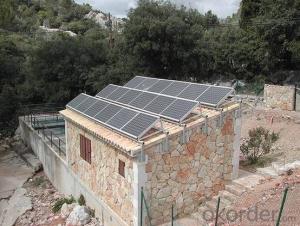High Efficiency off Grid Solar Systems with CE TUV RoHS Approved
- Loading Port:
- Shanghai
- Payment Terms:
- TT or LC
- Min Order Qty:
- 300 watt
- Supply Capability:
- 200000 watt/month
OKorder Service Pledge
OKorder Financial Service
You Might Also Like
| Quick Details | |||||
| Specification: | Normal | Application: | Home | Output Voltage (V): | AC110V/220V |
| Load Power (W): | 1000W | Solar Power (W): | 1000W | Work Time (h): | 24 hours |
| Certifications: | CE TUV RoHS | Cables: | 50m | Solar Panel Rack: | 1 set |
| Battery Rated Voltage: | 24V | Inverter output: | AC220V±5% | Grid Input Voltage: | AC165-275V |
| Rated DC Voltage: | 24V | Solar Input Max Voltage: | DC42V | Rated Ouput Power: | 1000W |
| Solar Panel Type: | Polycrystalline or monocrystalline silicon PV module | ||||
| solar system Specifications: | |||||
| Ref No. | OFF-SGHP-1000W | ||||
| System Basic Information | Solar Panel Rated Output Power: 1000W | ||||
| Solar Power for Daily Consumption: 4000WH | |||||
| Allowable Max Loads Power: 1000W | |||||
| Solar Panel | Crystalline Silicon PV Module solar panel , 250W*4pcs | ||||
| Controller-Inverter | Rated Ouput Power: 1000W | ||||
| Integrator | Rated DC Voltage: 48V | ||||
| Battery Rated Voltage: 48V Can fit the batteries into the box. | |||||
| Battery | 4pcs*12V/120AH per piece | ||||
| Solar Panel Rack | Flat-roof type mounting rack | ||||
| including complete fittings | |||||
| (Other types of racks can be customized as per client's requirement) | |||||
| Cables | 50m | ||||
| Connectors | 1 set | ||||
| Certifications | CE RoHS | ||||



FAQ
We have organized several common questions for our clients,may help you sincerely:
①what price for each watt?
it depends on the quantity, delivery date and payment terms,
②what is your size for each module? can you tell me the parameter of your module?
we have different series of panels in different output, both c-si and a-si. please take the specification sheet for your reference.
③Can you provide the peripheral products of the solar panels, such as the battery, controller, and inverter? If so, can you tell me how do they match each other?
Yes, we can, we have two companies for solar region, one is CNBM International, the other is CNBM engineering Co.
We can provide you not only the solar module but also Solar Cells, the off grid solar system, we can also provide you service with on grid plant.
④What is your warranty system?
Our product performance guarantees for 25 years
• 12 years guarantee for workmanship
• Timeliness of delivery
• Quality Products certified (TÜV, UL, CE, ISO)
⑤How do you pack your products?
We have rich experience on how to pack the panels to make sure the safety on shipment when it arrives at the destination.
⑥ Can you do OEM for us?
Yes, we can.
⑦How long can we receive the product after purchase?
In the purchase of product within three working days, We will arrange the factory delivery as soon as possible. The pecific time of receiving is related to the state and position of customers. Commonly 7 to 10 working days can be served.
- Q:How can solar energy systems reduce electricity bills?
- Generating free and renewable energy from the sun, solar energy systems have the potential to significantly decrease electricity bills. Unlike conventional electricity sources like fossil fuels, solar energy doesn't necessitate ongoing expenses for fuel or maintenance. Once installed, a solar energy system can produce electricity for many years, offsetting a substantial portion of a household's or business's electricity usage. By utilizing the power of the sun, solar energy systems can generate electricity when it is most in demand during daylight hours. Consequently, solar energy can directly compensate for electricity consumption during peak times, diminishing the need to draw power from the grid. Consequently, electricity bills can be drastically reduced or even eliminated, depending on the size and efficiency of the solar energy system. Furthermore, solar energy systems often provide homeowners and businesses with the opportunity to take advantage of numerous financial incentives and programs. These incentives may include tax credits, grants, or policies such as net metering, which allows surplus solar energy to be fed back into the grid and credited towards future electricity bills. These incentives can augment the financial advantages of installing solar energy systems, making them even more cost-effective. Additionally, solar energy systems offer long-term savings. As the cost of electricity from conventional sources continues to escalate, solar energy remains a steadfast and predictable investment. By securing a fixed cost for electricity generation, solar energy systems safeguard against future price hikes and inflation, ensuring that electricity bills remain low and foreseeable for years to come. Overall, solar energy systems provide a sustainable and economically viable solution for reducing electricity bills. By tapping into the abundant and free energy of the sun, households and businesses can enjoy substantial savings, financial incentives, and long-term stability in their energy costs.
- Q:Can solar energy systems be used in powering shopping malls or retail centers?
- Yes, solar energy systems can definitely be used to power shopping malls or retail centers. These large commercial spaces typically have large roof areas that can accommodate a significant number of solar panels. By installing solar energy systems, these establishments can reduce their reliance on grid electricity and lower their operational costs. Additionally, solar energy systems can help reduce carbon emissions and promote sustainability in the retail industry.
- Q:Are there any noise concerns associated with solar energy systems?
- Noise concerns may arise when using solar energy systems, though they are generally quiet. One of the main sources of noise is the inverter, which converts DC electricity from the panels into AC electricity for use. The inverter may emit a low humming noise, similar to that of a fridge or AC unit. However, the noise level is typically very low and not considered disruptive. Fortunately, advancements in technology have led to the development of quieter inverters that produce minimal noise. Some inverters have noise reduction features like soundproof enclosures or low-noise fans. Additionally, the location of the inverter can help minimize noise concerns. Placing it in a well-insulated area, away from living spaces, can further reduce potential noise disturbances. It's important to note that other components of a solar energy system, such as mounting structures and wiring, do not generate significant noise. Solar panels themselves are noiseless as they rely on sunlight for electricity generation, without any moving parts. In conclusion, while certain components of solar energy systems may have noise concerns, advancements in technology and proper installation practices have greatly reduced potential disruptions.
- Q:Can solar energy systems be installed in areas with heavy snowfall?
- Yes, solar energy systems can be installed in areas with heavy snowfall. However, it is important to consider the impact of snow on the system's performance and take necessary precautions during installation. Snow can temporarily reduce the amount of sunlight reaching the solar panels, which in turn reduces their energy production. However, the panels are designed to have a tilt and smooth surface, allowing snow to slide off easily. Additionally, advancements in technology have led to the development of snow-resistant solar panels that are more effective at converting sunlight into electricity even in snowy conditions. It is also worth noting that solar panels are often mounted at an angle to maximize their exposure to the sun, which helps to minimize snow accumulation. Overall, while heavy snowfall may impact the efficiency of solar energy systems, they can still be successfully installed and can contribute to renewable energy generation in areas with such climatic conditions.
- Q:Can solar energy systems be used in areas with high levels of dust or debris?
- Yes, solar energy systems can be used in areas with high levels of dust or debris. However, it is important to regularly clean and maintain the solar panels to ensure optimal performance. Dust and debris can reduce the efficiency of the solar panels by blocking sunlight and reducing their ability to generate electricity. Additionally, the design and installation of solar systems can incorporate measures to minimize the impact of dust or debris accumulation, such as tilt angles and protective coatings.
- Q:What are the devices needed for PV systems?
- Inverter. The utility model is a device for converting the direct current of the solar cell square and the storage battery to the alternating current, which is the key component of the photovoltaic grid connected power generation system. Since the solar cells and batteries are DC power supply, when the load is AC load, the inverter is essential. The inverter can be divided into independent operation inverter and grid connected inverter. The independent operation of the inverter is used for the independent operation of the solar cell power generation system, for independent load power supply. Grid connected inverter for grid connected solar power generation system, this paper introduces the photovoltaic grid connected generation system [1]. As shown in Figure 1, the grid connected inverter by IGBT power switching devices, control circuit of the switching element is regular continuous open or off, so that the output voltage polarity alternating, DC input into AC output. The inverter can be divided into square wave inverter and sine wave inverter according to the output wave type. The square wave inverter has the advantages of simple circuit, low cost, large harmonic component, and the utility model can be used for a system with a few hundred watts and a low harmonic requirement. Sine wave inverter is expensive, but can be applied to various loads.
- Q:What is the difference between solar thermal and solar photovoltaic systems?
- Solar thermal systems use the heat from the sun to directly heat water or air, while solar photovoltaic systems convert sunlight into electricity using solar panels.
- Q:Can solar energy systems be used in conjunction with other renewable energy sources?
- Yes, solar energy systems can definitely be used in conjunction with other renewable energy sources. This approach, known as hybrid renewable energy systems, allows for a more reliable and efficient power generation. By combining solar energy with sources like wind, hydro, or biomass, we can overcome the intermittent nature of solar power and ensure a continuous supply of clean energy. This combination also provides a more balanced and sustainable energy mix, reducing dependency on a single source and maximizing the overall renewable energy potential.
- Q:What is the role of solar energy systems in reducing heat island effect?
- Solar energy systems can help reduce the heat island effect by generating electricity from sunlight, which reduces the reliance on fossil fuels and consequently decreases the amount of heat and air pollution emitted into the environment. Additionally, solar panels can provide shade and help to cool urban areas by absorbing and reflecting sunlight, thereby mitigating the intensity of the heat island effect.
- Q:Can solar energy systems be installed in areas with high snowfall?
- Yes, solar energy systems can be installed in areas with high snowfall. While snow can temporarily reduce the efficiency of solar panels by covering them, it is still possible to generate electricity from solar energy during winter months. Additionally, advancements in technology have led to the development of snow-shedding designs and tilt systems that can help minimize snow accumulation on panels. Regular maintenance and cleaning can further optimize the system's performance in snowy conditions.
1. Manufacturer Overview |
|
|---|---|
| Location | |
| Year Established | |
| Annual Output Value | |
| Main Markets | |
| Company Certifications | |
2. Manufacturer Certificates |
|
|---|---|
| a) Certification Name | |
| Range | |
| Reference | |
| Validity Period | |
3. Manufacturer Capability |
|
|---|---|
| a)Trade Capacity | |
| Nearest Port | |
| Export Percentage | |
| No.of Employees in Trade Department | |
| Language Spoken: | |
| b)Factory Information | |
| Factory Size: | |
| No. of Production Lines | |
| Contract Manufacturing | |
| Product Price Range | |
Send your message to us
High Efficiency off Grid Solar Systems with CE TUV RoHS Approved
- Loading Port:
- Shanghai
- Payment Terms:
- TT or LC
- Min Order Qty:
- 300 watt
- Supply Capability:
- 200000 watt/month
OKorder Service Pledge
OKorder Financial Service
Similar products
New products
Hot products
Hot Searches
Related keywords




























